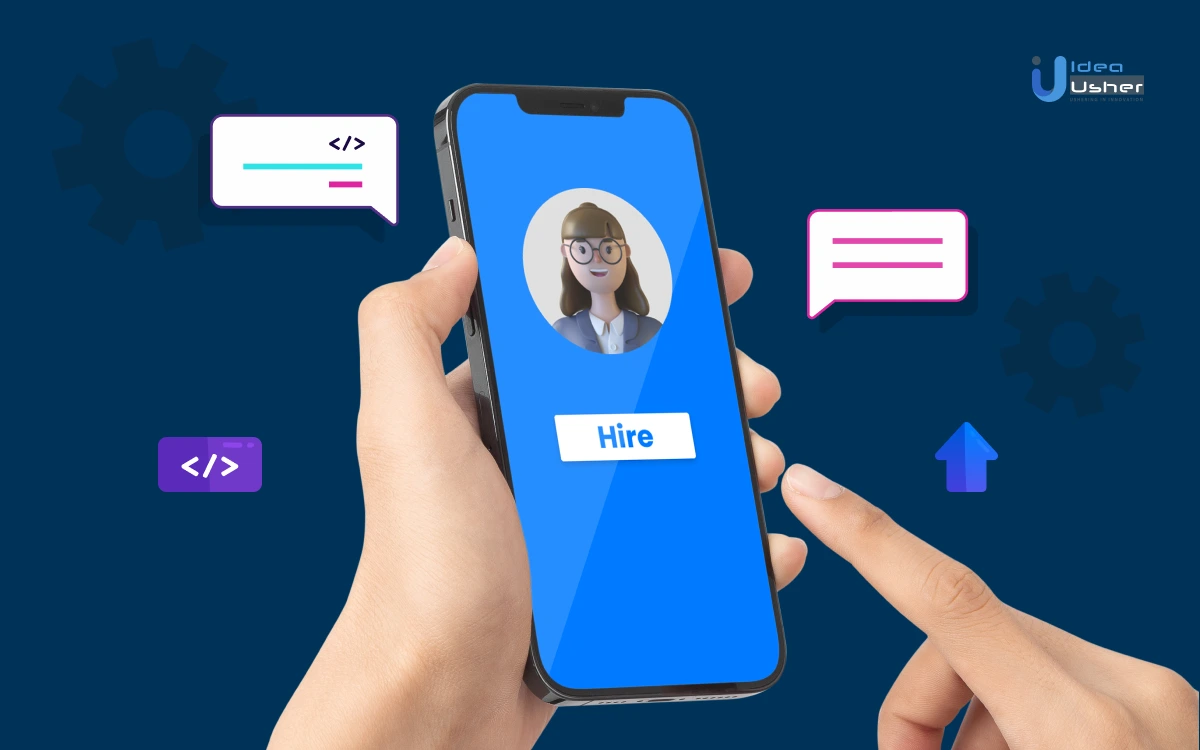
Do you happen to know a business facing challenges in recruitment, or is it you? Remote work is the new trend, and thus people are also into the easy approach for hiring or getting hired. Which is why recruitment is challenging these days, especially after the wave of the pandemic. If you want to ease the recruitment process in just a few taps, developing a Recruitment Application can help you through.
This blog will discuss how technology has shaped the recruitment and hiring market and how you can build a recruitment application for your business. Before we proceed with the development process, let’s find out:
Why Should You Build A Recruitment Application?
Applications provide easy and ready-made tech solutions to quicken, automate and improve processes. This capability has enhanced the dependability of applications, thus boosting the demand for one. Recruitment Application Development is a way where you can offer solutions to your or other businesses to improvise the hiring process or customize the process for digital recruiting without any hassle. But exactly why do you need an application?
Benefits Of Mobile Recruitment Application
1. Target The Audience You Want
One of the main advantages of top-notch recruitment apps is that they are data-driven. With the help of insights, you may better comprehend your target market and learn how to communicate with them. Additionally, the majority of businesses aim to recruit Millennials and Generation Z. These two groups value recruiters who are technologically savvy and mindful of their demands.
2. Easily Connect With Candidates
Anywhere you are, you have quick access to your candidate data with recruitment apps. You may use the data to analyze and connect with the individual at your convenience. Also, from the other perspective, the application makes it simpler to connect with potential applicants globally. You may carry out a variety of tasks in one centralized app with the help of simple-to-use dashboards.
3. Increase Output
Various tiresome duties that result in manual operations are part of the traditional hiring process. But with the aid of recruitment apps, you could hire more quickly and cut back on the number of complex tasks. Because of convenience, applications make it possible to engage with stakeholders, hire employees, and improve engagement.
4. Boost Communication And Response Time
With the use of recruitment applications, recruiters can interact with candidates and their teams more swiftly. By doing this, they encourage interest from job applicants and keep everyone informed of any changes or updates to the status of their applications. On the other hand, because these solutions go beyond interactions between recruiters and candidates, HR professionals may also improve their engagement with clients and stakeholders.
Besides this, the application may also allow HR professionals to communicate with candidates over texts or by sending a timely reminder for upcoming interviews and the onboarding process.
5. Notifications For Convenience
Notification from the application can serve as a reminder, so HR professionals don’t overlook important tasks, gatherings, or occasions. Also, by implementing a feature where you can pick what push alerts you want to get/send and what notifications are important, your application can do wonders at simplifying the job.
6. Boost Your Social Outreach
Due to a lack of qualified candidates, the HR sector is quite competitive. As a result, it’s critical that recruiters be able to contact individuals across numerous channels and strike up conversations quickly. This is why social media integration is made possible by recruitment apps, enabling HR teams to post job openings and interact with applicants on Facebook, LinkedIn, TikTok, and Instagram.
7. Recruitment Apps Can Save You Money
Despite the misconception that recruitment applications are pricey, these resources are typically reasonable and offer good value for money. They make it possible for recruiters to easily post job advertising, get in front of the competition, and immediately connect with candidates.
8. Automation Advantage
The usage of chatbots, e-mail automation, application tracking, and interview scheduling are all features that many recruiting apps can provide to HR professionals. As a result, recruiters can concentrate on conducting a thorough screening process and selecting the best candidate without worrying about the manual paperwork.
9. Streamline Collection Data
Recruiters can gather candidate information from a variety of sources, including job boards and social media sites, using the dashboards that are often included in recruitment apps. This allows recruiters to efficiently gather and maintain information on job seekers in one place, streamlining the further screening process.
10. Improved Candidate Resume Parsing
Recruitment apps can provide resume parsers which is another advantage. This tool allows HR professionals to use AI to evaluate applicant applications, identify candidates whose abilities meet the requirements, and select the ideal candidate for their requirements, which also reduces candidate sourcing time.
11. Mobile Application Benefit Job Seekers
An individual can utilize a recruitment app as a job candidate to easily browse the most suitable positions in one location and apply for multiple job applications. Significantly, this can help your business with an expanded customer base as digital applications are practically the second nature of today’s mobile-first generation. These young generations will account for more than 25% of the workforce in the next ten years, so a recruitment application could also be a fine investment.
The advantages above are why recruitment applications are a must-have for your business. The data below highlights the shifting tendency toward digital recruitment:
- Verified Market Research estimates that by 2028, the market for recruitment software will be worth USD 3.88 billion.
- Almost 98% of fortune 500 companies use recruitment software.
- During the forecast period of 2021–2028, the Asia Pacific region is anticipated to experience the fastest growth in the market for recruiting software.
- As per Jobscan, the majority, almost 98% of Fortune 500 organizations use recruitment applications.
- 94% of recruiters believe that recruitment applications have improved the hiring process based on a survey by Capterra.
- 86% of hiring companies acknowledged recruitment software as having sped up the hiring process.
- 75% of recruiters (ATS) use a recruiting system or applicant tracking system.
What Kind Of Recruitment Tool Can You Create?
The following categories of recruitment applications can be created that are used for hiring:
1. Candidate Relationship Management
CRM software focuses on establishing connections with possible job seekers. This develops a strong skill pool suitable for upcoming employment openings. It is an effective segmentation tool that automatically identifies talent and provides both passive prospects and active job seekers with an incredible experience.
2. Applicant Tracking System
Applications for a specific job vacancy are managed by an ATS or applicant tracking system. Recruiters and recruiting managers utilize ATS as applicant repositories, workflow automation tools, and compliance tools.
ATS examples include:
- Jobvite enables you to shorten the time it takes to fill positions and streamline the hiring process.
- For candidates, recruiters, and hiring managers alike, Greenhouse enhances the hiring procedure.
- Workable is a versatile, mobile-friendly platform that will simplify hiring.
- You can implement data-driven hiring using Recruitee, and many manual procedures can be automated.
3. Human Capital Management Software
HCM (human capital management) software is a comprehensive set of technologies that can assist companies in managing their workforce from hiring to retirement. As more businesses adopt the remote working paradigm, human capital management software is becoming increasingly important.
4. Job Boards and Aggregators
A job board is useful for consolidating job ads/listings in one location and allowing candidates to submit direct applications.
5. Video Tools
Video interviewing tools are growing in popularity as they make it easier for hiring managers to perform efficient prospect screening.
Important Features To Build In A Recruitment Application
There are some essential features that you can include in your recruitment application to provide maximum ease to your users and survive the competition in the hiring process.
| User Panel | Recruiting Manager Panel | Admin Panel |
| Sign up/login | Registration | Dashboard |
| Edit profile | Uploading jobs | CMS |
| Upload resume | Job posting/ job invitation | Job and management |
| Job filters | E-mailing offers | Real-time analytics |
| Mail resume | Filtering resume | User profile |
| Job alerts | Payment options | Recruiter profile |
| Save jobs | Resume downloads | Review and feedback |
1. User Panel
1.1 Sign Up/Login
For creating an account or logging in to an app using a social media account, e-mail address, or mobile number.
1.2 Edit Profile
For adding vital details in the profile, such as best abilities, professional experience, previous employers, and recommendations
1.3 Upload Resume
For updating and uploading the most recent résumé.
1.4 Job Filters
To see available employment that matches their qualifications and experience.
1.5 Mail Resume
For mailing resumes to the companies of choice who advertise vacancies for scheduling an interview.
1.6 Job Alerts
To receive notifications when employers post positions that meet their criteria or when an employer wishes to get in touch with them.
1.7 Save Jobs
To save positions, they could later apply for or bookmark jobs for future purposes to save time on job hunting.
2. Recruiter Panel
2.1 Registration
Hiring managers have the option of registering via e-mail, a mobile number, or a social media account and then instantly logging in.
2.2 Uploading Jobs
Employers can post jobs in accordance with open positions. The administrator can set experience and skill requirements for particular job posts when advertising positions on the employment portal.
2.3 Job Posting/Job Invitation
Employing managers have the option of posting job openings or inviting qualified individuals. They can afterward set up an interview with the candidates for the next step in the process.
2.4 E-mailing Offers
Depending on the number of openings, recruiters may also extend employment offers to qualified applicants.
2.5 Filtering Resume
To locate the right candidates, hiring managers might choose or filter through thousands of resumes.
2.6 Payment Options
Recruiters can add or remove services from membership plans and modify payment options and plans.
2.7 Resume Download
Recruiters can download the resumes of qualified individuals to schedule interviews and search for or filter the right resumes.
3. Admin Panel
3.1 Dashboard
It’s an essential feature as the management of users, recruiters, and consumer data across the board depends on the dashboard.
3.2 CMS
With the use of a CMS, administrators may quickly manage and edit all the material on the app.
3.3 Job Ad Management
All of the job postings that are visible or active on external websites and apps can be managed by admins.
3.4 Real-Time Analytics
For tracking the data on jobs allocated, the overall number of recruiters linked, jobs provided to users, and job search techniques provide insight for administrators.
3.5 User Profile
According to the settings and filters chosen, the administrator validates and manages user information and assigns jobs to the user. This feature can help in excluding fake listings.
3.6 Recruiter Profile
The admin oversees all information pertaining to a company’s basic concept, address, license, and recruiter profiles in order to weed out false job ads.
3.7 Review And Feedback
Admin gathers user and recruiter ratings and input to improvise and customize the application based on their need for their convenience.
Recruitment Software Technology Stack
| Programming Language | Frameworks | Databases |
| PHP, C#, .Net, Dart | Angular 1, Angular material, Node.js | PostgresQL, MongoDb |
| Cloud Platforms | Streaming Protocols | Mobile |
| Amazon S3, Amazon EC2 | Angular | React Native, Flutter with GetX |
Some Top Recruitment Applications In The Market
1. LinkedIn Recruiter
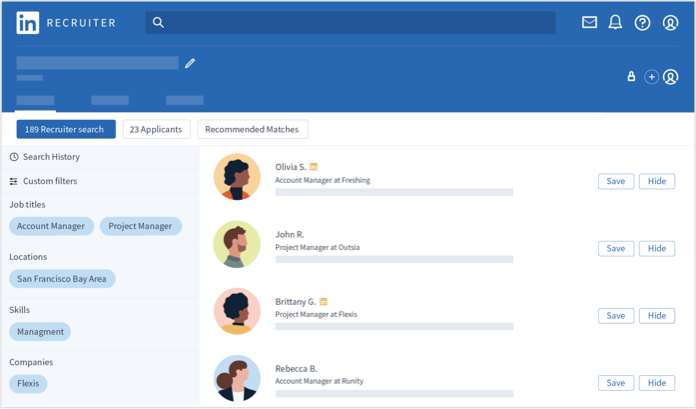
Employers may access LinkedIn’s social network of more than 630 million professional members through a platform known as LinkedIn Recruiter, which is a major player in the recruitment industry. Users can download this application on both iOS and Android, and it utilizes various networking and search methods in order to select the most qualified applicant.
The users of this recruiting app are given access to the app’s network, which makes it possible for recruiters to communicate with professionals from various fields and of all ages.
LinkedIn Recruiter uses intelligent filters and “spotlights” to reach out to job prospects with the skill sets most relevant to their requirement. It gives priority to those who are open to making a shift in their professional lives.
Through LinkedIn’s messenger, those posting jobs may communicate with potential prospects. The scheduling function of the app then gives users the ability to make an appointment for their interview with the company.
2. SHAPR
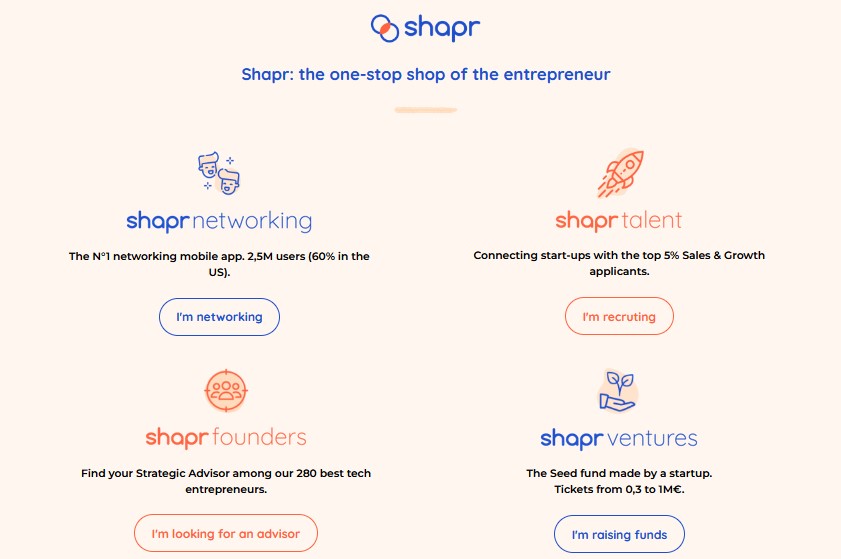
Shapr’s user experience is quite familiar to that of Tinder. It enables its users to interact with other professionals with goals and principles that are compatible with their own, opening up prospects for both recruiters and those looking for work.
Although it is marketed as a tool for professional networking, Shapr is an excellent choice for recruiting new employees since it enables users to connect effortlessly with other individuals who work in your industry. Users have access to a vetted list of other professionals working in their field who are interested in expanding their network and making new contacts.
One of the most notable features that set Shapr different from the other apps is that it has a user interface reminiscent of that of Tinder. When one person views the profile of another user, they have the option to “swipe left” to pass up a potential match or “swipe right” to indicate that they are interested in the prospective match.
The software will make a connection between the two if it detects that users share a common interest, at which point both users will be able to begin communicating with one another. Shapr users can select from a number of different in-person meeting alternatives, like going for a walk, grabbing coffee, hanging out after work, or even having a video chat with one another.
The users at Shapr aren’t looking for dates so much as they are looking for jobs, internships, and contacts to network with. Users can go through the profiles of other individuals who share the same interests as them and discover what those individuals hope to achieve (such as “find a new career” or “find mentors”). Recruiters can use this resource to take an active role in searching for potential new team members.
It will take less time to find a candidate for a job if an app similar to Tinder is utilized rather than posting an ad on one of the larger job boards. However, this may be a worthwhile investment if the user is constrained to a small geographic area or if only specific qualifications are required.
Shapr is an entirely free service that anybody may sign up for.
3. Monster
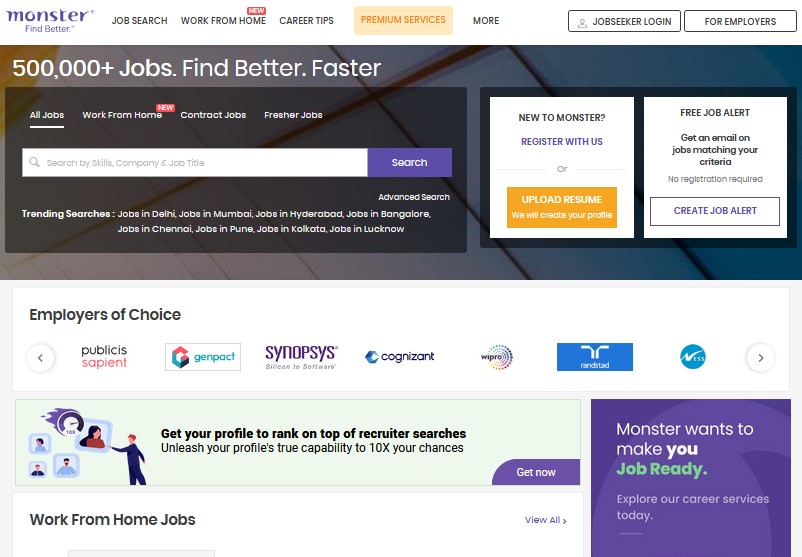
It was one of the original job boards on the internet, and now it has a mobile app for users to access their listings. Users (recruiter and candidate) can download the Monster Job Search application from the app store and playstore. It operates in a manner that is comparable to the other apps included here.
Employers can identify competent applicants, peruse their resumes, and contact those individuals they are interested in interviewing by using the application search feature.
4. JobSnap
An intriguing app called JobSnap, with headquarters in Los Angeles, caters to the interaction between Generation Z employees (those aged 22 and younger) and employers in industries with a high employee turnover rate. Jeff Boodie developed the software intending to assist job applicants who have a limited amount of professional experience on their resumes but a great deal of personality.
The app has a swiping interface like many others, but with several key differences. Candidates and employers alike are required to communicate their tales through the use of 30-second films rather than traditional profile cards. It’s an engaging approach for potential hires to demonstrate their individuality and inventiveness up front, allowing employers to assess their cultural fit in a shorter amount of time.
5. Calendly
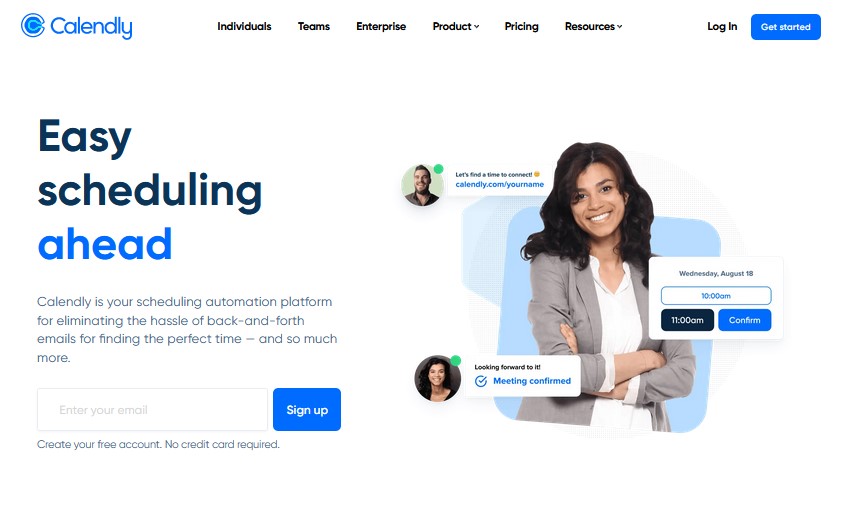
Calendly is an app that recruiters may use to organize meetings and interviews with people who could potentially become new employees or contractors. The Calendly app provides several helpful features besides its calendar and scheduling software. These features include the ability to arrange interviews and participate in video conferences.
Users cannot only arrange meetings but also check event settings and receive reminders of upcoming events on their devices. Users may check their availability using the app, see if they have free time, and then send a message to plan a meeting or other event within that time frame. This program allows users to sync their calendars with various calendars stored on external devices. The user can examine their whole itinerary at once, allowing themselves to prevent mistakenly reserving the same time again.
The most basic version of Calendly is free and referred to as the Basic edition. The Essentials version costs $8, while the Professional version costs $12. Monthly fees are assessed on an individual basis for each customer.
How To Build A Recruitment App?
The following steps will be taken during the creation of the recruitment app:
1. Gathering Requirements And Project Planning
Outlining the necessary software requirements should be the first step in your app development effort. Your software requirements will include information on how to create apps, develop features, and maintain them.
Here at this stage, you can identify the recruiting challenges and the business needs that must be met. That can help you choose the finest recruitment technology for your business. For instance, do you frequently hire for the same position or hire in bulk? Or do you have a lot of applicants for each opening? Do you worry that you won’t get the best candidate? Finding a solution will be much simpler once you are aware of the problems that need to be solved and additionally you can work on the loophole to target pain point.
2. Build A Software Development Team
Form a software development team with the following members to create a product that is competitive in the market:
- A project manager
- Mobile app developers
- Mobile app testers and
- UI/UX designers
3. Build Application Development Infrastructure
There are two parts to a mobile application: a frontend application and backend services that support the frontend. Your mobile app will require a scalable infrastructure with zero downtime, quick loading times, top-notch security, etc. Providers of mobile backend as a service handles backend tasks like API integrations, data storage, server configuration, and more. A cloud-based backend as a service is a good solution, and Amazon’s AWS Amplify is a popular MBaaS nowadays. It offers several capabilities, such as content management, push alerts, authentication, data storage, and more.
4. Choose An App Development Strategy
The steps of design, development, and testing for the creation of applications can be planned out using your software development process. Project managers typically use the agile technique for creating mobile applications. It is a good strategy because it enables developers to provide a functioning product to clients at the conclusion of each development iteration, which the client can then approve.
5. Reach Out To A Software Development Company
You’ll need programmers who are specialists in creating mobile applications using the newest technologies. You can hire hybrid software development business professionals with the necessary abilities to work for your project/recruitment application. This way, you can easily avoid the challenges you may encounter when employing individual freelance app developers.
The working paradigm of the freelancing market has drawbacks, such as:
- There is no assurance regarding the skill set of developers.
- There is no assurance that freelancers devote their full attention to your app development project.
- Maintaining regular communication with freelancers working on your project and keeping them on the same page with you successfully takes more time and effort.
Thus, outsourcing technical resources from a software development company like Idea Usher with experience in developing projects for your business, such as recruitment applications, is advisable.
6. Frontend And User Interface Design
Create a user interface for an interactive app. Consider users’ needs, preferences, and the best ways to keep them engaged as you design. If your design is customer-centric, a top-notch UX/UI can strengthen your brand identification and produce an immediate return on investment. In addition, you can develop a Minimum Viable Product (MVP) so that you may get to know the performance and feedback on the same for improvisation.
Learn how to build MVP in software development to create an MVP for your application.
7. Create The Landing Page For Recruitment Application
The landing page will allow users to interact with your application thoroughly. You can provide features for recruiters like job posting, job updation, filtering resume, resume download, payment gateway, etc. For employees/job seekers, you can include features like profile editing, uploading resume, job alerts, job filters, save resume, etc. and for administrators you can include CRM, ad management, profile management, review/feedback, etc. to have control over the process. At the admin end, you can also provide functionalities like monitoring user activity, for analyzing KPIs such as active users, downloads, revenues, and more.
This will help in profiting your campaigns and increasing the conversion rate because you will have a large and satisfied customer base and your application will also attain most downloads.
8. Test Your Recruitment Application
Your developers should be able to create mobile recruiting apps without bugs. In order to make sure that an app satisfies both its functional and non-functional needs, it should be able to conduct critical code reviews. Unit testing of code modules is the ideal option for testing the application. Your testing team can make use of automated quality assurance tools such as Espresso for testing Android apps, XCTest for testing iOS apps, and Appium for testing React-native apps.
9. Launch Your Recruitment Application
Your recruitment application can be released to the user market after comprehensive QA. At this phase, you will now concentrate on your app’s performance and user feedback on the app store/play store. You can assemble customer feedback, reviews, and recommendations for further improvisation of your application. For this, you might make use of programs like Qualaroo and UserReport. These tools aid in the creation of rapid pop-up surveys and display data as clear graphs.
WrapUp!
A recruitment application can be your ideal option if you want to attain a successful business because of the large user base. All you need to do is focus on market analysis, needs and requirements of recruiters and job seekers, simple UI/UX yet with several features to ease the hiring & applying process, and a budget-friendly skilled development team who knows their suits well. You can reach out to Idea Usher for your projects, as the professionals here are highly skilled and deliver the desired applications within the deadline and without surprises.
Contact Idea Usher at [email protected]
Or reach out at: (+1)732 962 4560, (+91)859 140 7140
FAQ
How can I monetize a recruitment application?
A recruitment application can be made profitable by running paid advertisement; offer paid premium services like resume editing, etc.; offering in-app purchases such as a career counseling appointment, etc.; supplying e-mail subscription services.
How do you build a database for recruiting?
Cold email outreach, providing your users with relevant content, improving your skills and learning from mistakes (user feedback), social media outreach, and other methods will help you create a strong recruitment database.
What one component of a recruitment tech stack is a must-have?
A set of automated tools and technology for each stage of the hiring process, from sourcing through onboarding, would make up a recruitment tech stack. Strong built-in analytics, smooth app integrations, and mobile friendliness should all be features of your IT stack.
Which recruitment company is ruling the market in 2022?
UltiPro, Harver, Hirevue, Click Boarding, GoHire, SmartRecruiters, Vervoe, and Pymetrics are just a few of the companies who are among the successful recruitment companies in 2022.









Rebecca Lal